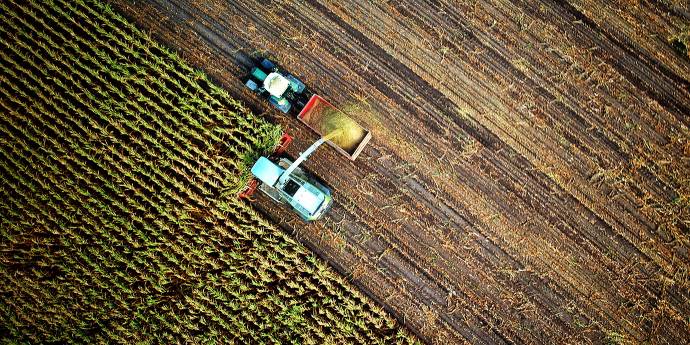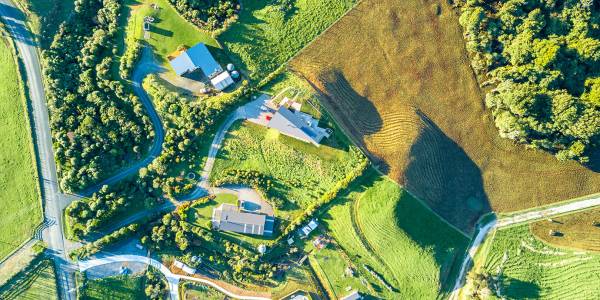The Economic Power of Gender Equality
Reasearch shows that diversity and equal roles for women delivers better results for people, for the planet and for profits.
While it is well known that reducing global carbon emissions to net zero will require widespread economic change, far too little attention has been paid to the issue of land use. The green transition will require a fundamental reconsideration of how we apportion rights to the planet’s surface.

“How much land does a man need?” asks Leo Tolstoy in a short story about a former serf named Pahom, who greedily accumulates land in czarist Russia’s equivalent of the American frontier.
In the end, Pahom’s servant answers the question as he buries his master with the same spade used to mark his vast property: “Six feet from his head to his heels was all he needed.”
Pahom’s pursuit of land came after Russia’s 1861 Emancipation Reform, which freed the serfs while keeping political power in aristocratic hands. Because land ownership was still the sole measure of economic worth, emancipation triggered a land rush.
But Tolstoy’s Russia was already behind the times. The old land economy was approaching its twilight and industrialisation would soon bring about a profound transformation.
Just a few decades after Tolstoy’s story appeared in 1886, agriculture – humanity’s dominant activity since the start of the Neolithic period – had been replaced by industrial production.
With the spread of the Second Industrial Revolution (railroads, telegraph and mass production of consumer goods, from bicycles to cheap books), asset management came to focus primarily on marginal productivity. Value was to be determined in competitive free markets by consumers’ preferences, not by the ownership of empty lands.
Economic theory soon evolved to accommodate the change. Marginalist economists such as Alfred Marshall and Arthur Pigou argued that a thing’s value lay in its long-run price (Adam Smith’s “natural” price), which reflected the balance between the cost of producing it and the willingness of consumers to pay for it based on its utility. In this framing, economists still struggled to accommodate differences in factors of production, like labour and land.
Then, American economist John Bates Clark extended marginalist ideas to factors of production themselves, treating labour, capital and land as homogenous capital with a monetary value corresponding to its contribution to production.
There were several problems with these theoretical advances. As Italian economist Piero Sraffa would later point out, any theory that depends on assuming hypothetical prices of inputs risks being circular. In particular, these theories ended up hiding the peculiarities of land.
Nonetheless, marginalism won out. It reflected the experience of exchanging goods and services along planetary value chains. Key components of a globalised economy could be sited anywhere. Exchanges were regulated by contracts that insulated consumers from any location-related liability. Indeed, the new macroeconomic theories ignored location altogether. Land thus receded into the background.
It is easy to forget that the classical economists would have been quite puzzled by the treatment of land as just another form of capital.
David Ricardo had introduced the idea of “economic rent” (unearned income) precisely because land was not like manufactured capital. He and his contemporaries knew that owning a location can imply a powerful monopoly. Yet after more than a century of marginalist orthodoxy, we have become blind to the economic nature of land. In a prominent economic journal’s recent special issue dedicated to the future of capitalism, land is barely mentioned at all.
“It is land, after all, that ultimately absorbs carbon, accommodates renewable energy, protects us from floods and collects the water needed to manage droughts. Once again, land is at the heart of the global economy.”
Things will change – because they must. Owing to climate change, countries are making ambitious commitments to protect vast swathes of land. And through the Paris climate agreement and pandemic “green recovery” packages, governments are accumulating a remarkable set of public liabilities and underwriting an “ecological transition” that will depend entirely on land.
It is land, after all, that ultimately absorbs carbon, accommodates renewable energy, protects us from floods and collects the water needed to manage droughts.
Once again, land is at the heart of the global economy.
In the ecological transition, every location on the planet holds several valuable attributes. One is the ability to sequester carbon. Under the right ecological conditions, plants augment soils, maintaining a terrestrial sink for carbon. This is no small matter: despite years of deforestation around the world, plant growth (mostly in temperate forests) has still been absorbing almost one-third of annual human emissions.
This global public good is partly the result of policy choices, from the African Union’s “Great Green Wall” to contain the Sahel, to China’s investments in its south western provinces’ forest economies. Already, China’s above-ground biomass has been absorbing more than one billion tonnes of carbon dioxide per year, roughly equal to what the global aviation sector emits. Europe and the United States are also large terrestrial sinks. Having reversed some of the deforestation of previous centuries, they, too, are helping to remove carbon from the atmosphere.
With the destructive effects of climate change already intensifying, changes in land use may be the only option for sequestering atmospheric carbon at scale over the short and medium term.
Of the approximately 100 million square kilometres (38.6 million square miles) of “habitable land” on the planet, agriculture (from livestock grazing to extensive cultivation) covers 50 million square kilometres, forests cover 40 million square kilometres, and most of the rest is shrubland.
The climate challenge will require us to augment all these ecosystems, implying land-use changes on an unprecedented scale.

Another crucial attribute of location is energy density. In an ecological transition, the landscape itself, rather than mineral reserves, will be our energy infrastructure.
For two centuries, our energy economy has rested on fossilised plants that stored millions of years of sunlight in underground fuel deposits. These stores have a very low land intensity. The current fossil-fuel energy infrastructure occupies an area roughly the size of Qatar.
Vast solar- and wind-power installations will be orders of magnitude more land intensive. To match the amount of energy that fossil fuels supply, renewables will need to be deployed on a continental scale.
According to one projection, biofuels will require an area the size of Russia (the world’s largest country by land mass), wind farms will require an area the size of India, and solar will require an area the size of Mexico.
“While most of the world’s people live in what amounts to 1.5 million square kilometres of built environment, the plumbing that makes modern urban density possible extends far beyond the pipes that run in and out of homes and office buildings.”
Climate adaptation and security also is dependent on land features because climate change manifests principally through water: floods, storms, droughts and so forth.
While most of the world’s people live in what amounts to 1.5 million square kilometres of built environment, the plumbing that makes modern urban density possible extends far beyond the pipes that run in and out of homes and office buildings.
A study from The Nature Conservancy calculates that the 100 largest cities depend on an upstream area roughly the size of Russia to collect, filter and transport water to nearly one billion people.
To protect these communities from catastrophic floods, storms and water shortages, most countries will have to re-plumb land on a scale that will dwarf anything undertaken by twentieth century modernist engineers.
Conflicts are likely because land will have to accommodate multiple attributes.
According to a 2020 study, India’s short term renewables goals alone will require an area the size of Himachal Pradesh, a state roughly the size of Croatia. Efforts to maximise that resource’s potential will lead to competition over thousands of square kilometres of forests and tens of thousands of square kilometres of agricultural land.
Many will argue for land to be allocated primarily on the grounds of efficiency. But beyond abstract principles and good intentions, people will disagree on which landscape features are most valuable.
Recent history suggests that forging a consensus on priorities will be difficult.
For example, following the adoption of the Convention on Biological Diversity at the 1992 Earth Summit in Rio de Janeiro, the US Congress passed the Elwha River Ecosystem and Fisheries Restoration Act, which, for the first time in the country’s history, authorised the removal of dams. It was a major victory for environmentalists and the Elwha people, but it also inaugurated a secular shift away from hydropower for baseload electricity production.
Around the same time, China went in the other direction by greenlighting the Three Gorges Dam, the world’s largest hydroelectric facility. The dam has been a central pillar in China’s development strategy, with far-reaching environmental effects.
Disagreements over such trade-offs will persist and intensify.
In 2010, the international community established the Aichi targets to protect biodiversity, hoping to halt losses of species and ecosystems. Ten years later, there has been progress in terms of indicators (such as hectares of protected land) that track activities, but little else of substance has been achieved. And though a new round of targets is now under discussion, ongoing disputes over what exactly is meant by “protection” or “nature” suggest the scale of the challenge posed by translating generic precautionary principles into concrete measurable outcomes.
“To address today’s environmental and climate challenges, we should revisit [American economist Henry] George’s original insight that economists and policymakers must treat land differently than other forms of capital.”
Transforming land use also will pose a challenge to standard economic policy tools.
Many economists and policymakers hope that marginalism can be expanded to accommodate environmental issues, and that markets can become an instrument of sustainability. Hence, in the 1990s, ecologist Gretchen Daily proposed that land be used as a marginal producer of “ecosystem services”.
And in 1998, economists Graciela Chichilnisky and Geoffrey Heal took this logic further, arguing that “privatising natural capital and ecosystem services […] enlists self-interest and the profit motive in the cause of the environment”.
Two decades later, however, markets for nature still have not emerged at a scale relevant to the problems we face.
Even though demand for land-based carbon sequestration has been growing rapidly – owing to corporations’ increasing need for “offsets” to uphold their net-zero commitments – the supply of such projects has lagged. Moreover, much of what is available is subscale and artisanal, and thus will struggle to meet long-term sequestration requirements.
With a vast and growing demand chasing a scarce, poorly defined supply, the conditions are ripe for a bubble – unless governments step in as suppliers of carbon offsets produced at a regional or national scale, with support from state-sponsored monitoring and verification infrastructure (so-called jurisdictional carbon).

All these difficulties suggest that the ecological transition will require more than a few tweaks to our relationship with the landscape.
First, we must recognise that our economic treatment of land is inadequate. In the late nineteenth century, American economist Henry George recognised land’s uniqueness. Focused on the problem of land monopolies in a highly unequal society, George advocated a single tax on land (which amounted to a tax on unearned rent). His ideas were broadly consistent with the classical liberal economic tradition and gained popular support, but were soon forgotten in the wake of the marginalist revolution.
To address today’s environmental and climate challenges, we should revisit George’s original insight that economists and policymakers must treat land differently than other forms of capital.
Second, like George, who never saw land nationalisation as particularly realistic or desirable, we must recognise that private ownership is the principal human institution governing the landscape. Private control of land accounts for almost all the world’s 50 million agricultural square kilometres. Even communist China uses proxies for private ownership in the management of agriculture (individuals and companies do not have outright ownership, but they can acquire usufructuary rights).
Moreover, private ownership has spread with land reforms. In the former Soviet Union, for example, 1.2 million square kilometres were privatised between 1990 and 2000; and land ownership in Latin America has followed a similar trend since the middle of the twentieth century.
Beyond agriculture, one-fifth of the world’s forests are also privately owned, and at least 15% of what is publicly owned is under private management (mostly in Russia). In Asia, usufructuary rights have doubled one form of forest ownership over the last two decades.
And indigenous people’s title claims are estimated to cover 80% of the world’s biodiversity. If enforced, they would give those communities control over many large unfragmented landscapes.
All told, roughly two-thirds of all habitable land – more than 60 million square kilometres – is either owned by someone or subject to some form of claim.
But private ownership poses a massive coordination problem for the ecological transition, which is often described as a science-led, global re-engineering of the planet. Most landowners lack the skills and resources needed to optimise the use of their properties. After all, the ecological transition requires distinguishing between not just land titles but the different attributes of the land to which they apply. Those best suited to manage carbon may not know how to ensure water security, and conservationists are not energy developers.
“And indigenous people’s title claims are estimated to cover 80% of the world’s biodiversity.”
So, we must find ways to disaggregate the attributes of each property.
Land ownership generally confers a bundle of rights: to use land, to produce goods and income, to exclude others, to control and transfer assets, to access resources, and so forth. In some common-law jurisdictions today, these rights are separable and attributable to different owners. In the US, for example, separation is achieved through easements, when owners sell some portion of their property rights (such as development, subdivision, or mineral rights) or donate them in exchange for a tax benefit.
This particular legal instrument has some precedent in conservation, owing to its popularisation in the 1950s by sociologist William Whyte, the author of the bestseller The Organization Man. Arguing that regulatory instruments like zoning were not enough to combat urban sprawl, Whyte proposed conservation easements, whereby landowners sell or donate development rights to their land, usually in exchange for a tax break.
Half a century later, American land trusts have used conservation easements on a significant scale: in 2020, almost 250,000 square kilometres in the US (an area the size of the United Kingdom) was classified as protected land and one-third of it was protected through easements.
The same model could be applied to attributes beyond conservation. Carbon contracts and flood servitudes, for example, use contract law to transfer lesser property rights, enabling consolidation and economies of scale for specific functions. This approach could be extended to other jurisdictions.
After all, it is not dissimilar to homeowners’ transfer of responsibility for network connectivity to a cable provider or capital value to a mortgage lender.
“According to the World Bank, only 30% of the world’s population possesses the legal basis – a registered land title – for owning, transferring and inheriting land. The lack of titles – and thus enforcement – will be a powerful obstacle to the ecological transition.”
Unbundling and precisely allocating the rights that come with private ownership will not be easy.
As economist Ronald Coase noted in the 1960s, addressing the transaction costs associated with property rights requires institutional solutions. A large cohort of property-rights holders cannot relate to each other through bilateral exchanges alone. Each transaction is complicated and will become more so as the number of recognised valuable land attributes (and the corresponding rights) increases.
Shortcuts and new institutions will be needed.
While the legal architecture will be complex, we already have some of the first building blocks. The first is information infrastructure. A lack of title registration is a well-known challenge in land economics and economic development. According to the World Bank, only 30% of the world’s population possesses the legal basis – a registered land title – for owning, transferring and inheriting land. The lack of titles – and thus enforcement – will be a powerful obstacle to the ecological transition.
Even where registries do exist, access is limited, making innovation difficult. In Germany, for example, confidentiality requirements restrict access to registry data. And even where there are no formal restrictions – as in the US where land registries are public – deeds and titles tend to be held in hundreds of local agencies where they are accessible only by paying a fee or engaging an expert. Opening and digitising public records is therefore an essential component of the ecological transition.
But title registration will not help if the ecologically valuable attributes of land are not recorded. Ownership must therefore be associated with detailed biophysical and geographical information. Satellite technology can establish the planetary distribution of land attributes at remarkably high resolution; but the relationship to ownership must be registered for those measurements to help delineate rights.
“Ultimately, a radical transformation of the landscape is not just a matter of economic management. It is fundamentally political, calling for a new relationship between land, the state and society.”
Establishing more nuanced property rights relating to the landscape will require institutional innovation. In some cases, natural owners will emerge and bring economies of scale to a specific attribute. For example, the enforcement of groundwater extraction limits in California has led to specialised asset managers like the Sustainable Water Impact Fund, which creates value by improving water management on land assets.
But the process will also create monopolies. This is not a new problem. Water utilities, for example, are natural monopolies tasked with managing a public good. As with most infrastructure, what is being paid for is not the commodity (water) but the social outcome (water security). The asset must be regulated to avoid excessive rent seeking.
As the landscape becomes an increasingly important part of society’s security infrastructure, each of its functions will require a mix of private and public finance.
As with water infrastructure or roads, the marginal value of these new infrastructural services may not be high enough to cover the average cost of provision. That is why most utilities are paid for through tariffs and taxes.
The same will likely happen with the ecological transition. Carbon markets are unlikely to scale up without new jurisdictional programmes in which governments effectively underwrite the transactions.
Ultimately, a radical transformation of the landscape is not just a matter of economic management. It is fundamentally political, calling for a new relationship between land, the state and society. Modern constitutionalism – the principal mechanism to regulate state power, balancing individual interests and collective benefits – has increasingly embraced the environment as a salient issue. We will likely see more of that as the inherent conflicts in multipurpose land use surface.
When Tolstoy gave his answer to how much land a man needs, another great Russian author, Anton Chekhov, replied that six feet of land may well be “what a corpse needs”, but not man. Humanity needs “the whole globe, all nature, where he can have room to display all the qualities and peculiarities of his free spirit”.
Maybe so. We are a planetary species. But our survival now depends on managing all lands on the planet in service of the most ambitious undertaking in human history. We must put land back where it belongs, at the heart of our economy.
See Chapter Zero New Zealand for more on climate governance.
